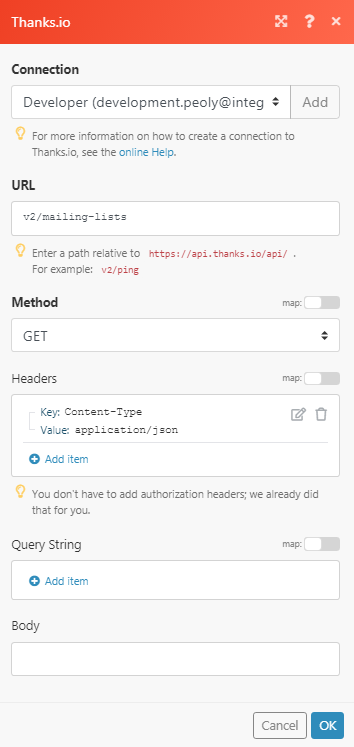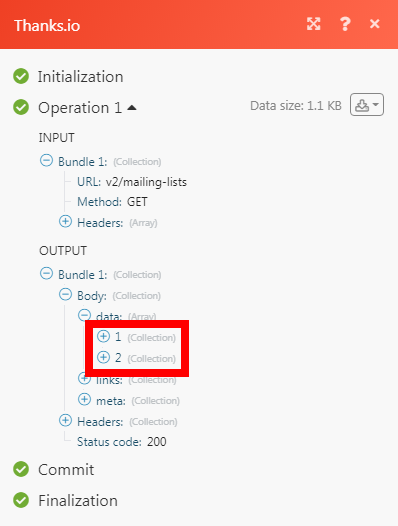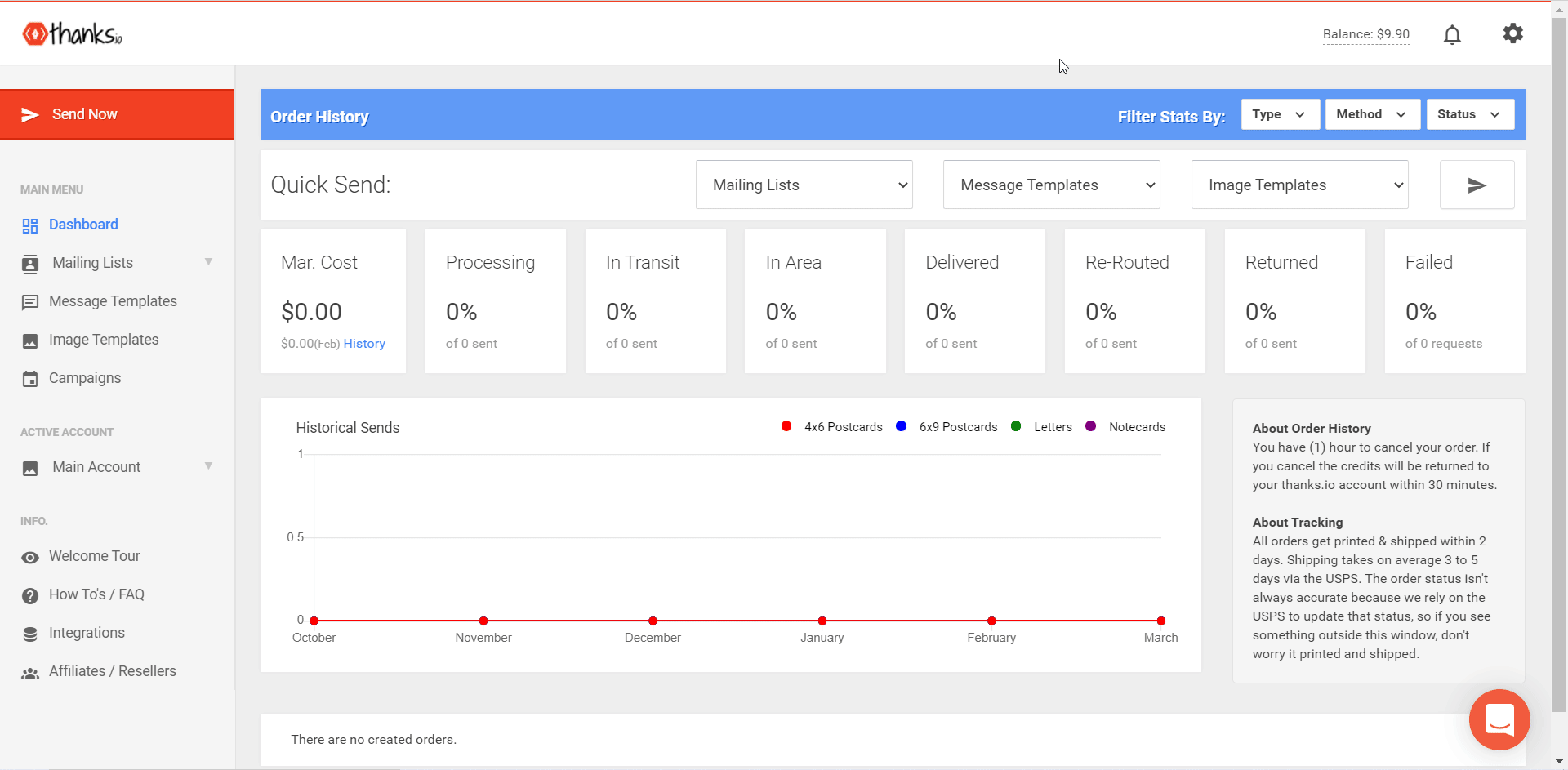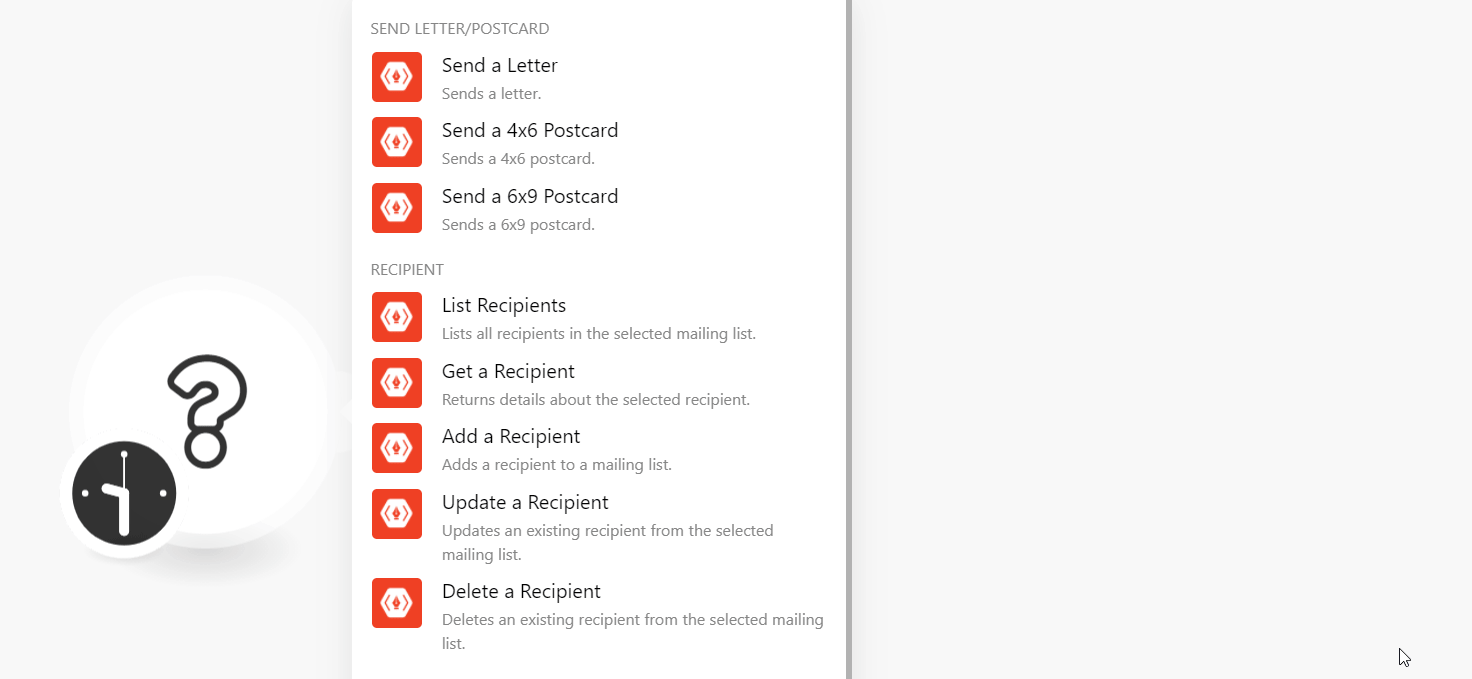| Active with remarks |
|---|
| This application needs additional settings. Please follow the documentation below to create your own connectionUnique, active service acces point to a network. There are different types of connections (API key, Oauth…). More. |
The Thanks.io modulesThe module is an application or tool within the Boost.space system. The entire system is built on this concept of modularity. (module - Contacts) More allow you to add, update, list. and delete the recipients and send postcards from your Thanks.io account.
Prerequisites
-
A Thanks.io account
In order to use Thanks.io with Boost.spaceCentralization and synchronization platform, where you can organize and manage your data. More IntegratorPart of the Boost.space system, where you can create your connections and automate your processes. More, it is necessary to have a Thanks.io account. If you do not have one, you can create a Thanks.io account at thanks.io.
![[Note]](https://docs.boost.space/wp-content/themes/bsdocs/docs-parser/HTML/css/image/note.png) |
Note |
|---|---|
|
The moduleThe module is an application or tool within the Boost.space system. The entire system is built on this concept of modularity. (module - Contacts) More dialog fields that are displayed in bold (in the Boost.space Integrator scenarioA specific connection between applications in which data can be transferred. Two types of scenarios: active/inactive. More, not in this documentation article) are mandatory! |
To connect your Thanks.io account to Boost.space Integrator you need to obtain the API Key from your Thanks.io account and insert it in the Create a connection dialog in the Boost.space Integrator module.
-
Log in to your Thanks.io account.
-
Click Settings (
 ) > API Access.
) > API Access. -
In the Personal Access TokenThe API token is a multi-digit code that allows a user to authenticate with cloud applications. More field, click + icon, enter a name for the token and click Create.
-
Copy the API TokenThe API token is a multi-digit code that allows a user to authenticate with cloud applications. More to your clipboard.
-
Go to Boost.space Integrator and open the Thanks.io module’s Create a connection dialog.
-
In the Connection name field, enter a name for the connection.
-
In the API Key field, enter the token copied in step 4, and click Continue.
The connection has been established.
Sends a letter.
|
Connection |
|
|
Front Image URL |
Enter the letter’s front image URL address. |
|
Handwriting Style |
Select or map the handwriting style for the letter. |
|
Message |
Enter the message text to add to the letter. |
|
Mailing Lists |
Add the mailing lists to which you want to send the letter. |
|
Return Name |
Enter the contact’s name to return the letter if undelivered. |
|
Return Address |
Enter the street address to which the letter should be returned. |
|
Return Address 2 |
Enter the street address to which the letter should be returned. |
|
Return City |
Enter the city name to which the letter should be returned. |
|
Return State |
Enter the state name to which the letter should be returned. |
|
Return Postal Code |
Enter the area postal code to which the letter should be returned. |
Sends a 4×6 postcard.
|
Connection |
|||||||||||||
|
Image TemplateTemplates are predefined scenarios that you can expand and customize to create new scenarios. You can then share these with friends and colleagues. More |
Select or map the image template to use for the postcard. |
||||||||||||
|
Handwriting Style |
Select or map the handwriting style to apply the postcard. |
||||||||||||
|
Message |
Enter the message text to add to the postcard. |
||||||||||||
|
Recipients |
Add the recipients of the postcard:
|
||||||||||||
|
Use Custom Background |
Select whether to apply the custom background to the postcard. |
||||||||||||
|
Custom Background Image URL |
Enter the background image URL address to apply to the postcard. |
Sends a 6×9 postcard.
|
Connection |
|
|
Image Template |
Select or map the image template to use for the postcard. |
|
Handwriting Style |
Select or map the handwriting style to apply the postcard. |
|
Message Template |
Select or map the message template to apply to the postcard. |
|
Address |
Enter (map) the complete address to which you want to send the postcard. For example, |
|
Radius Distance Miles |
Enter (map) the distance in miles. |
Lists all recipients in the selected mailing list.
|
Connection |
|
|
Mailing List ID |
Select or map the mailing list whose recipients you want to list. |
|
Updated Since |
Enter the date to list the recipient’s updated on or after the specified date. See the list of supported date and time formats. |
|
Limit |
Set the maximum number of recipients Boost.space Integrator should return during one execution cycleA cycle is the operation and commit/rollback phases of scenario execution. A scenario may have one or more cycles (one is the default).. |
Returns details about the selected recipient.
|
Connection |
|
|
Mailing List ID |
Select or map the mailing list whose recipients you want to list. |
|
Recipient ID |
Select or map the Recipient ID whose details you want to retrieve. |
Adds a recipient to a mailing list.
|
Connection |
|
|
Mailing List ID |
Select or map the mailing list to which you want to add the recipient. |
|
Street Address |
Enter the recipient’s street name. For example, |
|
Address 2 |
Enter the recipient’s street name. For example, |
|
Recipient Name |
Enter the recipient’s name. |
|
City |
Enter the recipient’s city name. |
|
Province |
Enter the recipient’s state or province name. |
|
Postal Code |
Enter the recipient’s area postal code. |
|
Country |
Enter the recipient’s country name. |
|
Date of Birth |
Enter the recipient’s date of birth. |
|
Custom 1 |
(Optional) Enter the custom fieldA feature in Boost.space that allows you to define and manage data within each module according to your specific needs. More name and values for the recipient. |
|
Custom 2 |
(Optional) Enter the custom field name and values for the recipient. |
Updates an existing recipient from the selected mailing list.
|
Connection |
|
|
Recipient ID |
Select or map the Recipient ID whose details you want to update. |
|
Mailing List ID |
Select or map the mailing list to which you want to add the recipient. |
|
Street Address |
Enter the recipient’s street name. For example, |
|
Address 2 |
Enter the recipient’s street name. For example, |
|
Recipient Name |
Enter the recipient’s name. |
|
City |
Enter the recipient’s city name. |
|
Province |
Enter the recipient’s state or province name. |
|
Postal Code |
Enter the recipient’s area postal code. |
|
Country |
Enter the recipient’s country name. |
|
Date of Birth |
Enter the recipient’s date of birth. |
|
Custom 1 |
(Optional) Enter the custom field name and values for the recipient. |
|
Custom 2 |
(Optional) Enter the custom field name and values for the recipient. |
Deletes an existing recipient from the selected mailing list.
|
Connection |
|
|
Mailing List ID |
Select or map the mailing list to which you want to add the recipient. |
|
Recipient ID |
Select or map the Recipient ID whose details you want to delete. |
Performs an arbitrary authorized API call.
|
Connection |
||||
|
URL |
Enter a path relative to
|
|||
|
Method |
Select the HTTP method you want to use: GET to retrieve information for an entry. POST to create a new entry. PUT to update/replace an existing entry. PATCH to make a partial entry update. DELETE to delete an entry. |
|||
|
Headers |
Enter the desired request headers. You don’t have to add authorization headers; we already did that for you. |
|||
|
Query String |
Enter the request query string. |
|||
|
Body |
Enter the body content for your API call. |
The following API call returns all the mailing lists from your Thanks.io account:
URL:
/v2/mailing-lists
Method:
GET

Matches of the search can be found in the module’s Output under BundleA bundle is a chunk of data and the basic unit for use with modules. A bundle consists of items, similar to how a bag may contain separate, individual items. More > Body > data.
In our example, 2 tasks were returned:

Returns order details by ID.
|
Connection |
|
|
Order ID |
Select or map the Order ID whose details you want to retrieve. |


